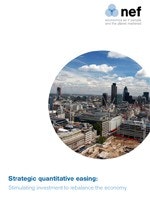Using QE to rebuild the UK economy – the Canadian way

Mark Carney, new Governor of the Bank of England, starts work today. It would certainly be useful, if he would start by seeking answers to questions on why Quantitative Easing and Funding for Lending are not working as expected.

A report entitled “Strategic Quantitative Easing” published today byt the New Economics Foundation (nef) says QE is not supporting the recovery and other measures such as Funding for Lendig scheme are threatening to create another housing bubble. It is calling for a strategic QE – investing in home building and energy efficiency, infrastructure and small business lending.
The Bank of England’s programmes of Quantitative Easing (QE) and Funding for Lending (FLS) are failing to stimulate GDP and rebalance the economy. Both policies falsely assume that the UK’s risk-averse capital markets, corporate sector and constrained banking system can be nudged into supporting the productive economy. We propose a new approach: one that channels investment directly into new housing, infrastructure and SME lending, boosting productivity and exports. QE must become less scattergun and more strategic, with reformed governance structures to match.
Read the report here.
Josh Ryan-Collins, the Senior Researcher at nef, has written an open letter to the new Bank of England governor Mark Carney urging him to get QE money in to the real economy as Canada did from 1944-1972:
Dear Governor Carney,
QE is being written about in the media as your great challenge. If you want more of it, as your predecessor did, how do you counter the argument that it is a policy with diminishing returns, just as likely to pump up house prices or financial assets as it is to trickle through to the real economy? If you want less, how do you unwind QE without creating turmoil in the financial markets, as has been the result of the recent announcements of the Federal Reserve?
We suggest a third, ‘Canadian way’.
In 1944, The Canadian government and recently formed Central Bank faced an enormous reconstruction challenge. One of the solutions was to create a new public bank – the Canadian Industrial Development Bank (IDB) – to support an SME sector desperate for funding with WWII having just ended.
Where was the money to come from given sky-high public deficit? The answer was simple: the Central Bank used its power of money creation to capitalise the IDB which would then lend to SMEs as needed. From 1944-1972, the IDB authorised 65,000 loans totalling $3 billion for 48,000 businesses, employing almost a million people. Not a single penny of taxpayers’ money was needed.
Today we’ve released a new report, arguing that the Canadian example should be adopted and taken further. Instead of buying government bonds and relying on financial markets and our sickly banking sector, the Bank should use its power of money creation to buy assets in intermediaries with a remit to invest in the real economy: bonds in the Green Investment Bank and British Business Bank, financing the Green Deal or capitalising a Public Interest Company to build much needed affordable and social housing.
Even with no additional QE purchases, a total of £100bn of QE purchased government bonds will come up for renewal in the next 5 years, equivalent to the government’s entire capital spending plans over the same period, announced last week by Danny Alexander.
How to achieve this whilst maintaining the Bank’s independence on monetary policy? Create a new body – the Monetary Allocation Committee (MAC) – that would be in charge of deciding how best to distribute Bank of England QE money. The Monetary Policy Committee (MPC) would remain in charge of the quantity of Central Bank money created, retaining its primary inflation remit. The MAC would staffed by independent experts but accountable to the Treasury and Parliament rather than the Bank, given its more fiscal remit.
The fact is that the Bank of England, through schemes like Funding for Lending and the Financial Policy Committee is already blurring the line between monetary and fiscal policy. Our proposal makes the division transparent and democratically accountable.
The result would be win-win-win: create sustainable growth and jobs, boost productivity and boost exports, all without increasing the public debt. What’s not to like?